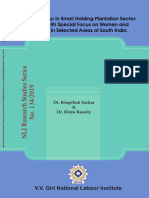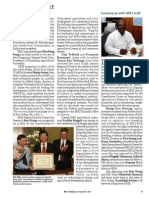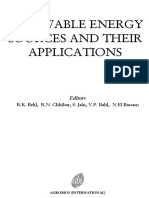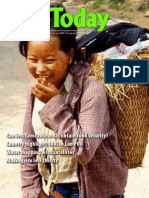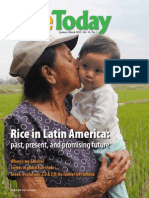RT Vol. 3, No. 4 Summing Up
RT Vol. 3, No. 4 Summing Up
Uploaded by
Rice TodayCopyright:
Available Formats
RT Vol. 3, No. 4 Summing Up
RT Vol. 3, No. 4 Summing Up
Uploaded by
Rice TodayOriginal Title
Copyright
Available Formats
Share this document
Did you find this document useful?
Is this content inappropriate?
Copyright:
Available Formats
RT Vol. 3, No. 4 Summing Up
RT Vol. 3, No. 4 Summing Up
Uploaded by
Rice TodayCopyright:
Available Formats
Summing up
by Peter Fredenburg
In the calculus of rice and global food security, China and India equal the rest of the world combined. The role of rice research in these countries is likewise great, as is the task of coordinating it for maximum benet
hina and India together accounted in 1999 for 38% of world population and 55% of all rice consumption. In 2000, their rice elds comprised 48% of global area planted to rice and produced 54% of the harvest. In the past year, responsibility for representing the International Rice Research Institute (IRRI) has changed hands in both countries. In September 2003, Tang Shengxiang completed 6 years of service as IRRIs rst liaison scientist for China, replaced by Zhao Kaijun. Last June saw R.K. Singh complete 9 years as IRRI liaison scientist for India, where his responsibilities were assumed by J.K. Ladha as IRRI representative. Transition in the two giants of the world of rice is an opportunity to celebrate the careers of the outgoing liaison scientists and to welcome their replacements in these two crucial IRRI country ofces after rst recalling how the countryofce system came to be. For its rst 3 decades, IRRI made do without ongoing country ofces. The institute supported incountry research with project ofces that were
18
Rice Today October-December 2004
set up as needed and loosely linked to IRRIs Training and Technology Transfer Department and its deputy director general for outreach. The project ofces notably in India, Indonesia, Thailand and, starting in the mid-1980s, Vietnam, Cambodia and Laos depended heavily on personal ties at IRRI headquarters in the Philippines to energize support for their activities.
Upgraded presence
Glenn Denning, head of technology transfer, drew on his experience in Indochina to champion systematizing the institutes in-country contacts by establishing permanent country ofces. January 1990 saw the reorganization of the Training and Technology Transfer Department into the Training Center under Dan Minnick and the new International Programs Management Ofce under Dr. Denning. Existing project ofces became country ofces that year, but significant upgrading of IRRIs presence in-country often depended on local initiative, as illustrated by R.K. Singhs start as liaison scientist in 1995. The rst thing I did was shift the IRRI-India Ofce, which was then located in a back house of a residential premises, to a more decent premises in Friends Colony, New Delhi, reported Dr. Singh (it has since moved to the National Agriculture Science Center near other Indian and international agricultural institutions). At the same time, we upgraded our ofce
WOMEN NEAR Hefei, in the Chinese province of Anhui, fertilize aerobic rice, a water-saving crop undergoing on-farm trials. Tang Shengxiang (opposite top, at left), IRRIs outgoing liaison scientist for China, checks a greenhouse trial with William Padolina (right), IRRI deputy director general for partnerships, and Chen Zonglong, vice president of the Yunnan Academy of Agricultural Sciences. R.K. Singh (opposite bottom, holding water bottle), outgoing liaison scientist for India, shares a light moment with farmers. Rice Today October-December 2004
19
ARIEL JAVELLANA
R.K. SINGH (right) with Ren Wang, IRRI deputy director general for research, and N.V. Krishnaiah, principal scientist in the Entomology Department of the Directorate of Rice Research in Hyderabad, India.
equipment and sent local staff for training to enhance their knowledge and skills with regard to modern tools, equipment and ofce protocol. IRRI-India was thus prepared to expand its list of projects from only a handful, according to Dr. Singh, to the current 44 research projects implemented with 53 participating institutions involving more than 270 Indian scientists directly and many more indirectly all coordinated through regular IRRI-India planning and review meetings. Improved links with the private sector and nongovernmental organizations supported work in promoting traditional aromatic rice and organically grown and hybrid rice, as well as facilitating on-farm
varietal trials and technology delivery. Strengthened ties with the media ensured routine press coverage of IRRIs activities in India. Drawing on a decades work from 1985 as director of research at Narendra Deva University of Agriculture and Technology in Faizabad, Uttar Pradesh, Dr. Singh was particularly active in several projects focused on eastern India, including research on mixed farming systems based on rice in rainfed lowlands and efforts to build partnerships with farmers through participatory varietal selection (see Taking Part in Rice Today, Vol. 3, No. 2, pages 22-26). He published research results in the books Physiology of Stress Tolerance in Rice (1996), Rice-growing Environments of Eastern India: An Agro-climatic Atlas (1999), Rainfed Rice: A Sourcebook of Best Practices and Strategies in Eastern India (2000), and Boro Rice (2003). During my tenure, I have also devoted some time to improving indigenous scented rices in India, Dr. Singh recalled. My efforts in this regard have helped identify a number of improved lines, which are now being tested in state and all-India coordinated trials. Some have been released by state and central varietal release committees. Dr. Singh co-edited two comprehensive books on the topic:
Aromatic Rices (2000) and A Treatise on the Scented Rices of India (2003). One other book published by Dr. Singh, Genetics and Plant Breeding, is a manual and source book for postgraduate students. A fellow of the Indian National Academy of Agricultural Sciences, Dr. Singh has additionally published dozens of papers, notes and abstracts in refereed journals, international proceedings and other venues. Today, he continues working to alleviate rural poverty with the nongovernmental organization Nand Educational Foundation for Rural Development.
Memorable events
Some memorable events during my tenure included India becoming signatory to the international status of IRRI in 1996 and the IRRIIndia dialogue in 1998, Dr. Singh reminisced. A highlight of the latter event was the luncheon meeting hosted for the IRRI director general and scientists by our prime minister along with his cabinet colleagues. Similarly, a highlight of Tang Shengxiangs tenure as liaison scientist for China was President Jiang Zemins formal opening of the rst International Rice Congress. The event which attracted more than 1,000 scientists from around the world and garnered extensive press coverage in China took place in Beijing in September 2002, just a year
Whos new
hange came with continuity on 18 June when J.K. Ladha started as the International Rice Research Institute representative for India. As IRRI coordinator of the Rice-Wheat Consortium for the Indo-Gangetic Plains since 1999, Dr. Ladha, an Indian national, has been a frequent traveler to his homeland during his 22 years at IRRI headquarters in the Philippines. I was the youngest IRS when I joined IRRI in 1982, recalled the energetic 52-year-old internationally recruited staff scientist. Because
Zhao Kaijun J.K. Ladha
Dr. Ladha was posted to India as an internationally recruited staff member, his new job title is IRRI representative, not liaison scientist as when the post is lled locally. A fellow of the Indian National Academy of Agricultural Sciences, American Society of Agronomy, and Soil Science Society of America, Dr. Ladha brings a wealth of research experience to the IRRI-India Ofce. This will be a challenge, he said as he prepared for the move. Im a scientist, and Ill continue to look after my research. At the same time, the job involves a lot of administration. In China, Zhao Kaijun came to the position of liaison scientist in October 2003 from the Chinese Academy of Agricultural Sciences in Beijing. Having obtained his doctorate in plant genetics and breeding in 1990 from the academys graduate school, he taught rice biotechnology in its Institute of Crop Breeding and Cultivation and was deputy director of its Key Laboratory of Crop Genetics and Breeding under the Ministry of Agriculture. The 42-year-old Dr. Zhao is co-holder of a U.S. provisional patent on plants resistant to fungal disease and the process of genetic modication that created them.
before Dr. Tangs departure. His career with IRRI had begun in 1980, barely half a dozen years after the rst tentative contacts between the institute and China, and only 4 years after the end of the Cultural Revolution. The rice scholar studied frequently at IRRI during the 1980s. In 1990, a year after becoming head of the Germplasm Department of the China National Rice Research Institute in Hangzhou, Dr. Tang became the China national coordinator of the IRRI-sponsored International Network for Genetic Evaluation of Rice (INGER, see Joint Account with Interest on next page). Following a stint as an IRRI consultant in 1996-97, Dr. Tang accepted appointment as liaison scientist for China which, surprisingly, did not yet have an IRRI country ofce. A frantic months preparation led in November 1997 to an IRRI-China dialogue in Beijing, at which 45 rice scientists set priorities for a more formal program of collaboration. From its newly established premises in the Beijing compound of the Chinese Academy of Agricultural Sciences, the IRRI-China Ofce initiated several collaborative projects on molecular breeding, hybrid rice development and use, aerobic rice breeding, rice functional genomics and shuttle breeding. Joint studies on nitrogen-use efciency came under the project Reaching Toward Optimum Productivity. Collaborative research on exploiting crop biodiversity for sustainable rice-disease management developed a suite of techniques that Chinese farmers now apply on more than 1.2 million ha in the provinces of Yunnan, Sichuang and Jiangxi. We now have 18 ongoing bilateral collaborative projects that engage 160 Chinese scientists in 38 participating institutions, reported Dr. Tang. The scientist noted that INGER germplasm has gured in 37 conventional rice varieties and 28 commercial hybrids released to Chinese farmers. In the past 6 years, we arranged the delivery of more than 220 Chinese rice varieties to the International Rice Genebank at IRRI, he added.
TAKING A BREAK during a meeting in Beijing are (from left) Mark Bell, head of the International Programs Management Ofce (IPMO); Margaret Ann Jingco, IPMO administrative coordinator; Tang Shengxiang, outgoing liaison scientist for China; Jojo Lapitan, IPMO senior manager; and Wang Zhongqiu, IRRI-China administrative coordinator. The covers of ve books (below) that contain rice research by R.K. Singh.
The IRRI-China Ofce has been a 2-way conduit of rice information, with Dr. Tang writing about IRRI in the Chinese media and publishing many scientic papers in both Chinese and English, and the ofce annually shipping some 200 issues of 18 Chinese rice-related scientic journals to the IRRI Library. In 2002, Dr. Tang was instrumental in arranging publication, with the nancial support of the Fujian Science and Technology Publishing House in Fuzhou, of the Chinese-language version of the 3rd edition of Rice Almanac, for which he also served as one of the two chief translators.
Timely inputs
Among the many Chinese awards received by IRRI scientists on Dr. Tangs watch was a 1999 rst prize from the Ministry of Education
recognizing his own research on the origin and evolution of rice. Dr. Tang is continuing to serve as the Hangzhou-based INGER national coordinator and will complete his 2002-05 term as China regional secretary of the Society for the Advancement of Breeding Researches in Asia and Oceania. Today, IRRI maintains country ofces in Bangladesh, Cambodia, China, India, Indonesia, South Korea, Laos, Myanmar, Thailand and Vietnam, with the central International Programs Management Ofce serving as the Philippine country ofce and will soon open a country ofce in Nepal. Staff consolidation brought restructuring full circle as the central ofce and the Training Center recombined in 2002 under the leadership of Mark Bell. IRRIs success depends on effective sharing of improved technologies with stakeholders and on timely inputs from national partners to help set research priorities, said Dr. Bell. We have helped our country ofces facilitate these exchanges by standardizing operating procedures, but local leadership still counts for a lot. Weve been fortunate to enjoy the services of such distinguished liaison scientists as Dr. Singh and Dr. Tang. As we adapt to changing needs in country ofces across Asia, I hope and expect that we will continue to attract the dedicated liaison scientists we need.
21
ARIEL JAVELLANA
20
Rice Today October-December 2004
IRRI
Rice Today October-December 2004
MADELYN LAPITAN
You might also like
- "Stray" by Cynthia RylantDocument4 pages"Stray" by Cynthia RylantJen0% (1)
- WheatDocument246 pagesWheatdonbosskiss67% (3)
- Section 1 - Living Organisms and The EnvironmentDocument11 pagesSection 1 - Living Organisms and The EnvironmentOsmany Madrigal100% (2)
- Copia de Merchandise ListDocument34 pagesCopia de Merchandise Listdiego fernando morera leonNo ratings yet
- Contoh Portfolio TaskaDocument20 pagesContoh Portfolio TaskaHidayah Hakimi83% (6)
- Rice Today Vol. 14, No. 2 GOTDocument2 pagesRice Today Vol. 14, No. 2 GOTRice TodayNo ratings yet
- NLI Research Studies Series No-134-Family Labour in Small Holding PlantationDocument64 pagesNLI Research Studies Series No-134-Family Labour in Small Holding PlantationL Sudhakar ReddyNo ratings yet
- Agricultural Extension System in IndiaDocument166 pagesAgricultural Extension System in IndiaCapung flyNo ratings yet
- RT Vol. 3, No. 1 PeopleDocument1 pageRT Vol. 3, No. 1 PeopleRice TodayNo ratings yet
- Rice Today Vol. 14, No. 2 Celebrating 50 Years of Impact Through Rice Research in IndiaDocument1 pageRice Today Vol. 14, No. 2 Celebrating 50 Years of Impact Through Rice Research in IndiaRice TodayNo ratings yet
- India and IRRIDocument2 pagesIndia and IRRIIRRI_resourcesNo ratings yet
- Floriculture Industry in IndiaDocument24 pagesFloriculture Industry in IndiaMuhammad Bilal BhatNo ratings yet
- Asian Agri HistoryDocument18 pagesAsian Agri HistorytariniNo ratings yet
- Scientometrics of Cereal Crops Research in India As Re Ected Through Indian Science Abstracts and CAB Abstracts During 1965-2010Document13 pagesScientometrics of Cereal Crops Research in India As Re Ected Through Indian Science Abstracts and CAB Abstracts During 1965-2010Suresh NatesanNo ratings yet
- FLOWERARRANGINGDocument31 pagesFLOWERARRANGINGMelissaNo ratings yet
- RT Vol. 5, No. 3 PeopleDocument1 pageRT Vol. 5, No. 3 PeopleRice TodayNo ratings yet
- IRRI Annual Report 2013Document10 pagesIRRI Annual Report 2013IRRI_resourcesNo ratings yet
- RT Vol. 5, No. 1 It's Not All About ResearchDocument1 pageRT Vol. 5, No. 1 It's Not All About ResearchRice TodayNo ratings yet
- RT Vol. 4, No. 1 The Year That Put Rice Back On The MapDocument4 pagesRT Vol. 4, No. 1 The Year That Put Rice Back On The MapRice TodayNo ratings yet
- Agripreneurship PDFDocument9 pagesAgripreneurship PDFKarthik RaoNo ratings yet
- RT Vol. 8, No. 4 Pioneer InterviewsDocument3 pagesRT Vol. 8, No. 4 Pioneer InterviewsRice TodayNo ratings yet
- Recent Trends & Advances in Food Science & Post Harvest TechnologyDocument21 pagesRecent Trends & Advances in Food Science & Post Harvest TechnologyDat Nguyen TienNo ratings yet
- Rice Today Vol. 14, No. 2Document37 pagesRice Today Vol. 14, No. 2Rice TodayNo ratings yet
- Pricivples Rice PhaiDocument642 pagesPricivples Rice PhaiVuthy CheyNo ratings yet
- Guru Gobind Singh Indraprastha University: A Project Work of Environmental Studies' OnDocument11 pagesGuru Gobind Singh Indraprastha University: A Project Work of Environmental Studies' OnRam KrishnaNo ratings yet
- A Project Work of Environmental Studies' On: "World Wildlife Fund in India"Document12 pagesA Project Work of Environmental Studies' On: "World Wildlife Fund in India"tabishNo ratings yet
- RT Vol. 3, No. 1 NewsDocument2 pagesRT Vol. 3, No. 1 NewsRice TodayNo ratings yet
- Evs ProjectDocument11 pagesEvs ProjectRahul Jain82% (11)
- IRRI - Constraints To High Rice YieldDocument424 pagesIRRI - Constraints To High Rice YieldrbmalasaNo ratings yet
- BiographyDocument3 pagesBiographygro_neeraj01No ratings yet
- Ar2006 07igidrDocument73 pagesAr2006 07igidrsneha n.pargheeNo ratings yet
- HIV AIDS ConsultantDocument5 pagesHIV AIDS ConsultantDr. Anil Pratap Singh100% (2)
- MineReclamation OperationManual - CleanedDocument91 pagesMineReclamation OperationManual - CleanedManuel Montenegro PérezNo ratings yet
- Competency SummaryDocument5 pagesCompetency Summaryanon-886935100% (1)
- M.S. Swaminathan AwardDocument39 pagesM.S. Swaminathan Awardtamanna2007vaishnavNo ratings yet
- 971104174X Content PDFDocument266 pages971104174X Content PDFFebiana YusidaNo ratings yet
- IOCL - Impact Assessment Report - Fodder Bank ProjectDocument82 pagesIOCL - Impact Assessment Report - Fodder Bank ProjectsatyajitNo ratings yet
- Jain University Puts Indian Traditional Knowledge Into The SpotlightDocument2 pagesJain University Puts Indian Traditional Knowledge Into The SpotlightxxxfarahxxxNo ratings yet
- Bienvenido O. Juliano, PH.D., Outstanding Filipino Scientist On Organic ChemistryDocument3 pagesBienvenido O. Juliano, PH.D., Outstanding Filipino Scientist On Organic ChemistryEdel Ann EvascoNo ratings yet
- Pig Production PDFDocument576 pagesPig Production PDFPeter100% (2)
- China and IRRI: Improving China's Rice Productivity in The 21st CenturyDocument112 pagesChina and IRRI: Improving China's Rice Productivity in The 21st CenturyIRRI_resourcesNo ratings yet
- RT Vol. 12, No. 1 Country HighlightDocument1 pageRT Vol. 12, No. 1 Country HighlightRice TodayNo ratings yet
- RT Vol. 6, No. 3 PeopleDocument1 pageRT Vol. 6, No. 3 PeopleRice TodayNo ratings yet
- SRI Book Final VersionDocument216 pagesSRI Book Final Versionต่วนยะห์ยา กาแม100% (1)
- BOOK Renewable Energy Sources and Their ApplicationsDocument369 pagesBOOK Renewable Energy Sources and Their ApplicationsTapas RanjanNo ratings yet
- Abstract Book IConARD 2021Document135 pagesAbstract Book IConARD 2021Akhmad Ansyor 'ancuiy'No ratings yet
- 103 Ijar-25755Document10 pages103 Ijar-25755Mikkie MolbogNo ratings yet
- The Current Thrust of Livestock Related Research in IndiaDocument28 pagesThe Current Thrust of Livestock Related Research in IndiamrsagbNo ratings yet
- Thesis On Rice in IndiaDocument7 pagesThesis On Rice in IndiaTracy Drey100% (2)
- Appropriate TechnologiesDocument1 pageAppropriate TechnologieskishoreyerasuNo ratings yet
- Current Status of Vegetable Research in IndiaDocument22 pagesCurrent Status of Vegetable Research in IndiaSanjay KutheNo ratings yet
- A Practical Guide To Nutrient Management-RiceDocument146 pagesA Practical Guide To Nutrient Management-RicedonbosskissNo ratings yet
- Ripple May-August 2012Document12 pagesRipple May-August 2012Irrc IrriNo ratings yet
- Review On The Role of Small Scale IrrigationDocument18 pagesReview On The Role of Small Scale IrrigationDaguale Melaku AyeleNo ratings yet
- Resume of Sridhar GutamDocument12 pagesResume of Sridhar GutamSridhar GutamNo ratings yet
- 3 A. Prosiding ICSTLM LengkapDocument19 pages3 A. Prosiding ICSTLM LengkapMa IntangNo ratings yet
- Rice Thesis in IndiaDocument7 pagesRice Thesis in IndiaTina Gabel100% (2)
- CH 26Document9 pagesCH 26rainarenNo ratings yet
- Role of HorticultureDocument24 pagesRole of HorticultureNishant KumarNo ratings yet
- 26 Icfost: Food and Nutrition Challenges: Role of Food Science and TechnologyDocument8 pages26 Icfost: Food and Nutrition Challenges: Role of Food Science and TechnologyIranna UdachanNo ratings yet
- International Rice Research Notes Vol.24 No.2Document48 pagesInternational Rice Research Notes Vol.24 No.2ccquintosNo ratings yet
- Kyusei in USA PDFDocument183 pagesKyusei in USA PDFBoris JabucaninNo ratings yet
- Government of India Ministry of Statistics and Programme ImplementationDocument23 pagesGovernment of India Ministry of Statistics and Programme ImplementationProf. Nandan Nawn (D/o Economics)No ratings yet
- Rice Today Special Supplement For The Philippine Department of Agriculture Management Committee Meeting, 6-8 April 2015Document48 pagesRice Today Special Supplement For The Philippine Department of Agriculture Management Committee Meeting, 6-8 April 2015Rice TodayNo ratings yet
- Rice Today Vol. 14, No. 2Document37 pagesRice Today Vol. 14, No. 2Rice TodayNo ratings yet
- Rice Today Vol. 14, No. 2 Home-Made Noodles From GhanaDocument1 pageRice Today Vol. 14, No. 2 Home-Made Noodles From GhanaRice TodayNo ratings yet
- Rice Today Vol 14, No. 2 Averting Hunger in Ebola-Hit CountriesDocument1 pageRice Today Vol 14, No. 2 Averting Hunger in Ebola-Hit CountriesRice TodayNo ratings yet
- Rice Today Special SupplementDocument27 pagesRice Today Special SupplementRice Today100% (1)
- Rice Today Vol. 14, No. 1 A Tale of Two Women Leading Rice Revolutions in Latin AmericaDocument2 pagesRice Today Vol. 14, No. 1 A Tale of Two Women Leading Rice Revolutions in Latin AmericaRice TodayNo ratings yet
- Rice Today Vol. 14, No. 1 Green Revolutions 2.0 & 3.0 No Farmer Left BehindDocument2 pagesRice Today Vol. 14, No. 1 Green Revolutions 2.0 & 3.0 No Farmer Left BehindRice TodayNo ratings yet
- Rice Today Vol. 14, No. 1 A Four Decade Quest To Improve Rice in Latin America and The CaribbeanDocument2 pagesRice Today Vol. 14, No. 1 A Four Decade Quest To Improve Rice in Latin America and The CaribbeanRice TodayNo ratings yet
- Rice Today Vol. 14, No. 1Document37 pagesRice Today Vol. 14, No. 1Rice TodayNo ratings yet
- Rice Today Special Supplement For Japan's Minister of Finance and The World Bank's Executive DirectorDocument35 pagesRice Today Special Supplement For Japan's Minister of Finance and The World Bank's Executive DirectorRice TodayNo ratings yet
- Rice Today Vol. 13, No. 4 Women Who Moved MountainsDocument2 pagesRice Today Vol. 13, No. 4 Women Who Moved MountainsRice TodayNo ratings yet
- Bricks Reading 60 Level 3 - SB Answer KeyDocument18 pagesBricks Reading 60 Level 3 - SB Answer Keykevineng7010No ratings yet
- NutritionalProducts082305 000Document12 pagesNutritionalProducts082305 000api-3757907No ratings yet
- Banquet Brochure - Hyatt Regency Taghazout - EngDocument25 pagesBanquet Brochure - Hyatt Regency Taghazout - EngOuaLyad AhmadNo ratings yet
- M7 Risk Anlysis FMEA HACCPDocument24 pagesM7 Risk Anlysis FMEA HACCPnursaidah100% (1)
- Tenasia Business Plan Final PaperDocument19 pagesTenasia Business Plan Final PaperTemmo DevisNo ratings yet
- Ikea Kitchen Planning GuideDocument12 pagesIkea Kitchen Planning GuideNifty100% (1)
- 2018 Effect Formulation and Process Extrudability Starch FoamDocument9 pages2018 Effect Formulation and Process Extrudability Starch FoamkesdamileNo ratings yet
- Book 12 BDocument14 pagesBook 12 BAbo TalebNo ratings yet
- New Hall Wedding BrochureDocument10 pagesNew Hall Wedding BrochureНатали Костова БарбоваNo ratings yet
- The Polymeal PlanDocument3 pagesThe Polymeal PlanFrancisco Chacón Lozsán KonradyNo ratings yet
- Stress ManagementDocument40 pagesStress ManagementRotche Balbuena100% (1)
- Information Sheet: Danish PastriesDocument3 pagesInformation Sheet: Danish Pastriesdefa rey100% (1)
- Bucket ListDocument100 pagesBucket ListMichelleZengNo ratings yet
- Unit 4 Food and Beverage SectorDocument8 pagesUnit 4 Food and Beverage SectorLyleNo ratings yet
- GM Diet Day 4 BreakfastDocument10 pagesGM Diet Day 4 BreakfastJPNo ratings yet
- Activity 3Document4 pagesActivity 3KylaMayAndradeNo ratings yet
- Clever GretelDocument3 pagesClever GretelChristian Axel100% (1)
- Learn The Propagation of Dioscorea To Harvest DiosgeninDocument5 pagesLearn The Propagation of Dioscorea To Harvest DiosgeninDr.Eswara Reddy SiddareddyNo ratings yet
- Excerpt PDFDocument10 pagesExcerpt PDFerikNo ratings yet
- New Oxford Social Studies For Paksitan TG 1Document76 pagesNew Oxford Social Studies For Paksitan TG 1gul100% (1)
- Jaipan Industries LimitedDocument23 pagesJaipan Industries LimitedkushalgargNo ratings yet
- PART 1 COLLOCATION-idiom-phrasalDocument14 pagesPART 1 COLLOCATION-idiom-phrasalAnh Đào TrầnNo ratings yet
- (2g Net Carb!) Gluten Free & Keto Tortillas - Gnom-GnomDocument2 pages(2g Net Carb!) Gluten Free & Keto Tortillas - Gnom-GnomCiupi TikNo ratings yet
- Soal Pat B.ing 11Document7 pagesSoal Pat B.ing 11H. SALIMINo ratings yet
- Composting 101 FinalDocument16 pagesComposting 101 FinalPau MalabananNo ratings yet
- Lab Report - MilkDocument11 pagesLab Report - MilkOscarNo ratings yet






